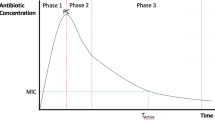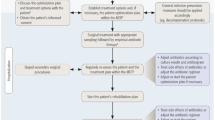Abstract
Purpose
Periprosthetic infection after total hip arthroplasty is a devastating complication. A two-stage protocol with the temporary insertion of an antibiotic-laden cement spacer is the gold standard treatment for chronic infections (Clinics (Sao Paulo) 62:99–108, 2007; Clin Orthop Relat Res 427:37–46, 2004; J Arthroplast 14:175–181, 1999; Clin Orthop Relat Res 467:1848–1858, 2009; J Arthroplast 20:874–879, 2005; J Arthroplast 24: 607–613, 2009; Clin Orthop Relat Res 469:1009–1015, 2011; Hip Int 20:26–33, 2010; J Arthroplast 24:1051–1060, 2009; J Bone Joint Surg Br 91:44–51, 2009). Some authors, however (Int J Med Sci 6(5):265–73, 2009), report mechanical complication rates with spacers in excess of 50 %.Therefore, the aim of this study is to determine (1) the mechanical complications associated with enclosed articulating partial load-bearing spacers when treating periprosthetic hip infections and (2) possible factors of influence.
Methods
Between 2000 and 2011, 138 patients received an antibiotic-laden cement spacer as part of a two-stage protocol. The overall frequency of complications (spacer fracture, dislocation, femoral fracture with enclosed spacer, spacer fracture with dislocation, protusion into the pelvis) was recorded. Potential influencing factors (‘mould spacer’ vs. handmade spacer, Steinmann pins as an endoskeleton, addition of vancomycin into the spacer) were analysed.
Results
The mean age at the time of the first stage operation was 69.3 ± 10.5 years. Overall, 27 of 138 patients suffered one of the above-mentioned complications (19.6 %). Spacer fracture occurred in 12 cases (8.7 %) and dislocation in another 12 (8.7 %). There was also one periprosthetic femoral fracture with a spacer in situ, one dislocation with a simultaneous spacer fracture, and one protrusion into the pelvis (0.7 % each).
Conclusions
Our data revealed an overall complication rate of 13.2 % with a mould spacer enclosing a Steinman pin. The mechanical complication rate of over 50 % reported by some authors cannot be confirmed. As a consequence, we recommend using a mould spacer with an enclosed Steinman pin as an endoskeleton to minimize the complication rate.




Similar content being viewed by others
References
Cabrita HB, Croci AT, de Camargo OP, de Lima ALLM (2007) Prospective study of the treatment of infected hip arthroplasties with or without the use of an antibiotic-loaded cement spacer. Clinics (Sao Paulo) 62:99–108
Evans RP (2004) Successful treatment of total hip and knee infection with articulating antibiotic components. Clin Orthop Relat Res 427:37–46
Fehring TK, Calton TF, Griffin WL (1999) Cementless fixation in 2-stage reimplantation for periprosthetic sepsis. J Arthroplast 14:175–181
Fink B, Grossmann A, Fuerst M, Schafer P, Frommelt L (2009) Two-stage cementless revision of infected hip endoprostheses. Clin Orthop Relat Res 467:1848–1858
Hofmann AA, Goldberg TD, Tanner AM, Cook TM (2005) Ten-year experience using an articulating antibiotic cement hip spacer for the treatment of chronically infected total hip. J Arthroplast 20:874–879
Incavo SJ, Russell RD, Mathis KB, Adams H (2009) Initial results of managing severe bone loss in infected total joint arthroplasty using customized articulating spacers. J Arthroplast 24:607–613
Leung F, Richards CJ, Garbuz DS, Masri BA, Duncan CP (2011) Two-stage total hip arthroplasty: how often does it control methicillin-resistant infection? Clin Orthop Relat Res 469:1009–1015
Romano CL, Romano D, Logoluso N, Meani E (2010) Long-stem versus short-stem preformed antibiotic-loaded cement spacers for two stage revision of infected total hip arthroplasty. Hip Int 20:26–33
Toulson C, Walcott-Sapp S, Hur J, Salvati EA, Bostrum M, Brause BD, Westrich GH (2009) Treatment of infected total hip arthroplasty with a 2-stage reimplantation protocol. J Arthroplast 24:1051–1060
Whittaker JP, Warren RE, Jones RS, Gregson PA (2009) Is prolonged systemic antibiotic treatment essential in two-stage revision hip replacement for chronic Gram-positive infection? J Bone Joint Surg (Br) 91:44–51
Garvin KL, Hanssen AD (1995) Infection after total hip arthroplasty: past, present, and future. J Bone Joint Surg Am 77:1576–1588
Lange J, Troelsen A, Thomsen RW, Soballe K (2012) Chronic infections in hip arthroplasties: comparing risk of reinfection following one-stage and two-stage revision: a systematic review and meta-analysis. Clin Epidemiol 4:57–73
Berend KR, Lombardi AV Jr, Morris MJ, Bergeson AG, Adams JB, Sneller MA (2013) Two-stage treatment of hip periprosthetic joint infection is associated with a high rate of infection control but high mortality. Clin Orthop Relat Res 471(2):510–518
Jacobs C, Christensen CP, Berend ME (2009) Static and mobile antibiotic-impregnated cement spacers for the management of prosthetic joint infection. J Am Acad Orthop Surg 17(6):356–368
Fehring TK, Odum S, Calton TF, Mason JB (2000) Articulating versus static spacers in revision total knee arthroplasty for sepsis. The Ranawat Award. Clin Orthop Relat Res 380:9–16
Jung J, Schmid NV, Kelm J, Schmitt E, Anagnostakos K (2009) Complications after spacer implantation in the treatment of hip joint infections. Int J Med Sci 6(5):265–273
Anagnostakos K, Fürst O, Kelm J (2006) Antibiotic-impregnated PMMA hip spacers: current status. Acta Orthop 77:628–637
Leunig M, Chosa E, Speck M, Ganz R (1998) A cement spacer for two-stage revision of infected implants of the hip joint. Int Orthop (SICOT) 22:209–214
Magnan B, Regis D, Biscaglia R, Bartolozzi P (2001) Preformed acrylic bone cement spacer loaded with antibiotics. Use of two-stage procedure in 10 patients because of infected hips after total re- placement. Acta Orthop Scand 72:591–594
Duncan CP, Beauchamp C (1993) A temporary antibiotic-loaded joint replacement system for management of complex infections involving the hip. Orthop Clin North Am 24:751–759
Ries MD, Jergesen H (1999) An inexpensive moulding method for antibiotic-impregnated cement spacers in infected total hip arthroplasty. J Arthroplast 14:764–765
Koo KH, Yang JW, Cho SH, Song HR, Park HB, Ha YC, Chang JD, Kim SY, Kim YH (2001) Impregnation of vancomycin, gentamicin and cefotaxime in a cement spacer for two-stage cementless reconstruction in infected total hip arthroplasty. J Arthroplast 16:882–892
Shin SS, Della Valle CJ, Ong BC, Meere PA (2002) A simple method for construction of an articulating antibiotic-loaded cement spacer. J Arthroplast 17:785–787
Takahira N, Itoman M, Higashi K, Utsiyama K, Miyabe M, Naruse K (2003) Treatment outcome of two-stage revision total hip arthroplasty for infected hip arthroplasty using antibiotic-impregnated cement spacer. J Orthopedic Sci 8:26–31
Schöllner C, Fürderer S, Rompe JD, Eckhardt A (2003) Individual bone cement spacers (IBCS) for septic hip revision—preliminary report. Arch Orthop Trauma Surg 123:254–259
Kummer FJ, Strauss E, Wright K, Kubiak EN, Di Cesare PE (2008) Mechanical evaluation of unipolar hip spacer constructs. Am J Orthop 37:517–518
Thielen T, Maas S, Zuerbes A, Waldmann D, Anagnostakos K, Kelm J (2009) Development of a reinforced PMMA based hip spacer adapted to patients’ needs. Med Eng Phys 31(8):930–936
Conflict of interest
I certify that I have not signed any agreement with commercial interest related to this study which would in any way limit publication of any and all data generated for the study or to delay publication for any reason.
Author information
Authors and Affiliations
Corresponding author
Additional information
An ethical review committee statement has been accorded.
Rights and permissions
About this article
Cite this article
Faschingbauer, M., Reichel, H., Bieger, R. et al. Mechanical complications with one hundred and thirty eight (antibiotic-laden) cement spacers in the treatment of periprosthetic infection after total hip arthroplasty. International Orthopaedics (SICOT) 39, 989–994 (2015). https://doi.org/10.1007/s00264-014-2636-z
Received:
Accepted:
Published:
Issue Date:
DOI: https://doi.org/10.1007/s00264-014-2636-z




